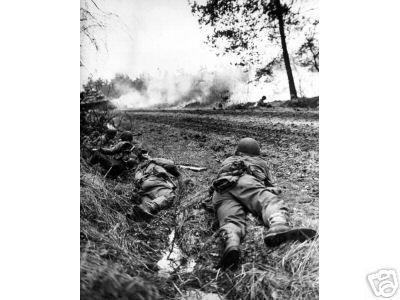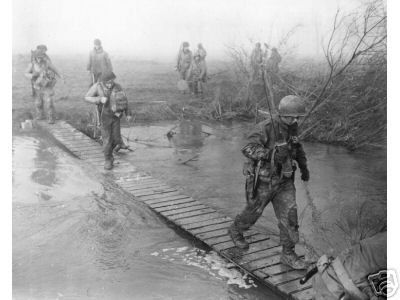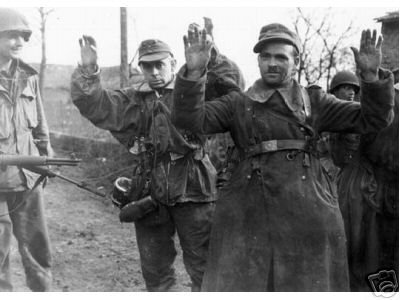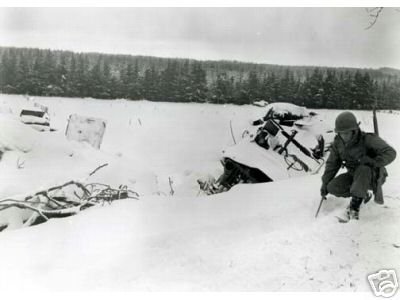|

Men of the 120th Inf. Regt., 30th Infantry Division, passing through a
German village, as they move up to the front lines near Warden, Germany.
Stamped on back "US Army Photo 21 Nov 1944". |

photograph depicting men from the American 30th Infantry Division in a
firefight somewhere east of the Rhine River at the end of March, 1945. The
soldier second from the right has just been shot. |
|

a platoon of GI's from the 30th "Old Hickory" Infantry Division crossing
the Roer River on February 23, 1945 during Operation Grenade. The 30th
Infantry Division ranked as one of the elite line units produced by the
U.S. Army during WWII. The division saw combat throughout the 1944-45
campaign and played key roles in the Normandy campaign, the breakout at
St. Lo, and the Battle of the Bulge. The 30th consistently faced extremely
tough opposition, frequently from SS Panzergrenadier units. Ferocious in
the attack, resolute on defense, the division became known to the Germans
as "Roosevelt's SS Troops" for their extraordinary performance on the
battlefield. The 30 Division ended the war pushing deep into the ruins of
the 3rd Reich, where the men linked up with a Russian spearhead outside
Magdeburg on the Elbe River in April, 1945. The great historian, S.L.A.
Marshall, once referred to the 30th as the "Finest infantry division in
the European Theater." |

soldiers of the 2nd Battalion, 120th Infantry Regiment, 30th Infantry
Division, taking German soldiers prisoner near Krauthausen, Germany on the
afternoon of February 23, 1945. The 30th took part that day in Operation
Grenade, the combat assault across the Roer River that gave the 9th Army a
bridgehead into Germany that was soon used as a springboard to the Rhine
River. |
|

Battle for Mortain by Keith Rocco. In August 1944, after the Normandy
invasion of June and subsequent breakout at St. Lo, in July, the German
High Command was prepared for a massive counter-offensive in an attempt to
throw the Allied Armies back into the sea. Hitler, and his generals, moved
massive amounts of armor and infantry to the area of Mortain, France, 150
miles west of Paris. At H-Hour, 7 August 1944, the troops of the XLVII
Panzer Corps rolled forward in Operation Luttich with the 2nd SS Panzer
Division headed directly for Mortain and Hill 317, a key terrain feature
in the central sector of the attack, Above are depicted part of the
Anti-tank Company, 3rd Battalion, 120th Infantry Regiment, 30th Infantry
Division (N.C., S.C., Tenn.) during fighting on the second day. They had
set up a roadblock adjacent to Hill 317, where the 2nd Battalion, 120th
Infantry was dug in directly north of Mortain. The crews, manning the 57mm
anti-tank guns, and troops of the 2nd Battalion with anti-tank rockets,
were responsible for destroying over 40 vehicles during the action and
stopped the German onslaught in the area. On the 7th of August, the
roadblock and Hill 317 were surrounded and bypassed by the main body of
German forces. The group surrounded on Hill 317, commanded by Capt.
Reynold Erichson -- about 700 men -- were protected by a ring of artillery
fire from the 35th Infantry Division artillery and fighter-bomber sorties
flown by the 2nd Tactical Air Force RAF. This kept the Germans from taking
Hill 317 and stopped the momentum of the counterattack in the area on the
first day. The 35th Infantry Division, attacking the German penetration
from the southwest, relieved the besieged troops at noon on 12 August. In
one of the outstanding small-unit achievements of the war in Europe, the
defenders held out for six days, sustained 300 casualties, but denied the
enemy a key objective. For their valiant actions on Hill 317, the 120th
Infantry Regiment was awarded a Presidential Unit Citation. This proud
fighting tradition of the 30th Infantry Division is perpetuated by the
30th Infantry Brigade, North Carolina Army National Guard.
|

unlucky American combat engineer who drew the delightful task of probing
for mines along a road leading to St. Vith, Belgium that had already
claimed numerous American vehicles, which can be seen half-buried in the
snow in the background. The GI is Private William Bouck, and he belonged
to the 291st Engineer Battalion of the 30th Infantry Division. The photo
was taken January 21, 1945. |